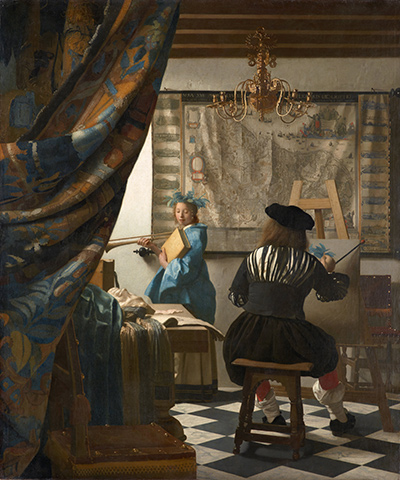In The Art of Painting, it is almost like looking through a window, into the artist's studio. One might even say that it is similar to gazing at a photograph, which just may be close to the truth, as many experts assert that Vermeer utilised a camera obscura, a precursor to the modern camera, in his works.
When one thinks of the Dutch painter Johannes Vermeer, the image that often comes to mind is of The Girl With the Pearl Earring. The artist's name might even conjure up images of his many other depictions of domestic interior scenes from 17th century middle class life in the Netherlands. However, of all these paintings, perhaps no other is more compelling, or has a history more complex than The Art of Painting.
The painter is busy painting at his easel while a girl dressed as Clio, the muse of history, models for him, standing in front of a window we cannot see. In her arms she holds a trumpet, symbolic of fame, and a large book, the title of which we cannot see. The source of the light is obscured by a curtain, but everything touched by the light is clearly visible.
The sunlight reflects off of the chandelier hanging from the ceiling, the small brass tacks on the chair in the foreground, and even the creases on the map hanging on the wall. The artist is dressed in fine clothes. This formal and elaborate style of dress suggests the painter exists in a more elevated place in society, more dignified than a common craftsman.
As for the painter depicted here, it is yet unknown if this is a self portrait of Vermeer. While it seems perfectly reasonable to assume that this may be the case, we cannot be certain. Until quite recently, very little was known about Vermeer's life in Delft, and his physical appearance, like many other details of his life, remain a mystery.
One thing that is certain, however, is this specific painting held a special significance for the artist. The Art of Painting was created some time during the late 1660s, but was never sold, in spite of the fact that Johannes Vermeer endured significant financial hardship. Vermeer kept the painting in his possession until his death in 1675 at the young age of 43.
After his death, Vermeer's widow, Catharina Bolnes, sold some of his paintings to help pay off their debts, but transferred ownership of The Art of Painting to her mother to prevent it from being seized by creditors.
As it turned out, creditors would not be the only ones to develop an interest in procuring The Art of Painting. In 1677, many Vermeer paintings were sold at an auction held at the Guild in Delft. It is unknown who acquired the picture at that time, but it did resurface eventually, and was on a display open to the public in the Czernin Museum in Vienna in 1813.
Count Jaromir Czernin tried to sell the painting in 1935, but the Austrian government forbade the export of artworks at that time. Soon after, Reichsmarschall Hermann Göring made an attempt to acquire the painting, and in 1940, it was purchased by Adolf Hitler. The painting remained at Hitler's residence in Munich until after the end of the war, when it was recovered by Allied Forces and returned to Vienna.
Johannes Vermeer never achieved fame during his lifetime. He did not take on students. He did sell a few paintings while he was still alive and reached moderate local success, but only produced two or three paintings a year, which mainly sold in Delft, thereby stunting the spread of his reputation. For several years, history forgot about Vermeer, aside from a few art aficionados in his home of The Netherlands.
Upon the rediscovery of Vermeer's art in the 19th century, his influence began to permeate the art world and continue on into the 20th century, inspiring the likes of Salvador Dali and the American painter, Thomas Wilmer Dewing. The Art of Painting has a complex and profound history, which is fitting for a painting that depicts the role of the artist and his relationship to history.




